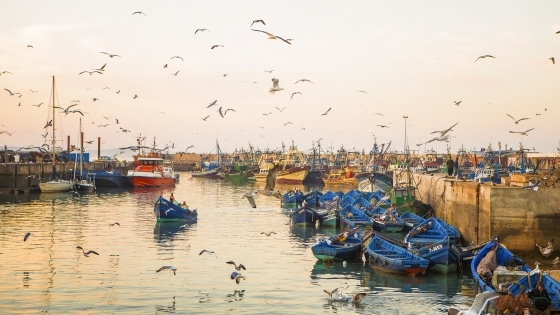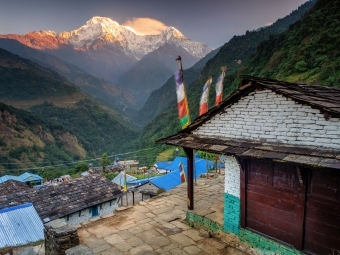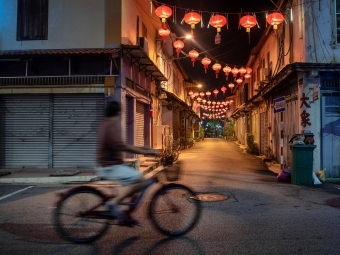Online Exclusive: Q&A With Photo Journalist and Archaeologist Matt Stirn '11

Traditional fishermen return to the port in Essaouira, Morocco with their daily catch. Once the port for Timbuktu and one of the largest in North Africa, Essaouira is struggling to maintain a traditional and sustainable fishing practice as large-scale commercial fishing has devastated resources in the region.
Stirn’s unique career combines his love of nature, skills as an archeologist and paleoecologist, and eye for a story.
Related Story: Journey Around the World, Courtesy of Photographer Matt Stirn's Stunning Images
Your reverence for the natural world shines through in your work. When did that fascination begin, and how has it been nurtured throughout your life?
You could almost say that conservation and a connection to the natural world is in my blood. I grew up on a ranch in Jackson Hole, Wyoming, at the foot of the Teton Mountains. It truly is a wildlife paradise where on any given day of the year you can find herds of elk, moose, bears, eagles and even wolves trotting through the forest.
My family’s connection to the ranch began when my great-grandparents established it as one of the first conservation easements in the region, forever protecting it from development. Growing up on the ranch I formed a deep connection to nature and developed a personal understanding of how hard it is to save. My interest in conservation grew as I began to travel and see firsthand how wildlife and traditional culture continue to be threatened everywhere, and that the two subjects are inextricably linked. Whether I try to or not, almost all of my archaeology and journalism work always comes back to the natural world and our complex relationship with it as humans.
Why did you choose to pursue archeology and paleoecology as a career?
Early on in my education I discovered that archaeology offered a unique and spectacular way to see the world. To fully understand an ancient site, you are required to consider everything around it, including the landscape, environment, geology, ecology and modern-day inhabitants. There is perhaps no better way to more fully immerse yourself into a location, its people, and their fascinating histories.
I was introduced to archaeology when I was 12 years old. A team from the University of Wyoming was excavating a 10,000-year-old campsite near my middle school, and my parents arranged for me to help volunteer for an afternoon. That afternoon turned into two weeks of work at the site, which subsequently transformed into a 20-year career, as I kept in touch and continue to work with many members of that team today. In high school I was introduced to the allure of travel and exploration in archaeology when I was invited to join Dr. Robert Ballard (of Titanic fame) on an expedition to discover shipwrecks in the Black Sea off of Ukraine.
I am a bit of an oddity when it comes to archaeology, as I am not completely enamored with the past. I am very interested in it but can’t spend days in museums like most of my colleagues. Rather, I am drawn to the forensic and problem-solving aspects of the discipline and love the challenge of combining various scientific techniques and lines of evidence to try to answer questions about ancient sites, cultures and artifacts.

Sunrise over Annapurna South from Landruk Village, Nepal
Your focus on human adaptation to high elevation landscapes is quite specific—what is it about that particular subject that interested you?
When I was 13 years old, I went on a backpacking trip at summer camp into the Wind River Mountains in Wyoming. While out collecting firewood one night near camp I found an obsidian arrowhead and was curious about the people who made it, and what they were doing in such an extreme landscape. During my freshman year at Davidson, I had an opportunity to finally study this topic and realized that it was a niche in archaeology that very few people had ever looked at, anywhere in the world! Most people thought that alpine landscapes were too harsh for ancient people to live in, so nobody looked and as a result, mountains across North America offered an incredible “blank-spot” on the map to explore. With the help of professors Bill Ringle at Davidson and Rich Adams at the University of Wyoming, I found myself on an incredible journey into the relatively new field of high-elevation archaeology.
How did you explore your interests at Davidson, and were you inspired by a particular experience or professor?
If it were not for my time at Davidson, I do not think I would be where I am today. It was both a combination of a liberal arts education and several amazing professors who helped me develop skills to pursue an exciting career in archaeology and journalism. Both of those professions are multidisciplinary in nature, and being at a place like Davidson allowed me to explore a vast array of subjects that would help me later on (even if I didn’t know it at the time).
In any given class at Davidson, we were required to interweave a large variety of subjects. Being taught how to research, analyze and then present a complicated project in a cohesive way were among the most valuable skills I learned. Those skills made graduate school seem like a breeze and allowed me to succeed in pursuing complex projects in my career. Time spent with Dr. Bill Ringle and Dr. Mike Toumazou helped inspire my interests in archaeology, and I cannot thank Dr. Jonathan Berkey and Dr. Shelly Rigger enough for their craft and patience in teaching me how to write like a professional.
Have you achieved your goal of bridging the gap between scientific information and the public—how has your work been received, and do you feel it’s making a difference?
As a journalist it is always difficult to know if your story really “worked,” or if it had the impact you hoped for. But since I started covering archaeological and scientific stories, I’ve received a lot of kind letters from people saying how excited they were to learn about a topic or culture they previously didn’t know anything about. For me, these simple letters are proof that it is working, and my stories are making a difference.
Every time I can publish an archaeological story in a place that normally doesn’t feature such topics, I call it a minor victory. If I can get people who typically don’t think about archaeology or science to stop for a moment, look deeply at a picture, and become intrigued about scientific discovery, history, or conservation, I’ve accomplished everything I set out to do.
Your work requires you to travel extensively. How have you gotten through this past year, with travel curtailed?
Between archaeology research, story assignments and leading photography workshops, I tend to go on nearly a dozen international trips a year. It is a lot of work and constant momentum, but I’ve learned to make it feel normal. When everything came to a pause last spring, it was definitely an adjustment. For the past couple of years, I’ve been focusing on photography, and a stationary life during the pandemic allowed me to write a lot more. Between our apartment in Boston and the ranch in Wyoming, I was also able to spend much more time photographing and exploring places close to home rather than constantly focusing on locations on the other side of the world.
I was extremely lucky that I completed the largest story thus far of my career weeks before the pandemic hit. I spent several weeks in Sudan exploring the ancient Kingdom of Kush and how this fascinating culture became widely unknown to the world. The story gained more traction than I ever expected and ended up being published across multiple magazines in eight countries and 10 languages. So even though I couldn’t travel during the past year, I was able to stay busy and relive some amazing memories.

A man rides his bike past red lanterns left over from Chinese New Year in the town of Malacca, Malaysia.
What’s the strangest, most interesting, most enlightening thing that’s ever happened to you in the field?
- During a deep-water archaeological survey of the Black Sea, the research vessel we were on (crew included) was confined by the Ukrainian and Russian navies. It turns out that during our detainment we were the first American ship to enter the Russian Black Sea Naval base in Crimea since the second world war.
- I have an unusual knack for running into heads of state during my travels and assignments. I’ve met a few different prime ministers of Greece at the beach during rest days on archaeological projects, and two years ago, while pursuing a story for National Geographic Travel about tea in Kuala Lumpur, I asked a man on the street for breakfast recommendations only to find out a few minutes later that he was the Malaysian prime minister.
- One of the most special memories was when I was photographing wild orangutans in Sumatra. As a rainstorm approached an orangutan mother wove an umbrella out of leaves and held it over her newborn’s head as the rain began to pour. Watching that was truly wondrous.
- There was also that one time I got my mom tear gassed in Greece. The year after graduating Davidson, my wife and I got a job working at the British School in Athens. During a family visit, my parent’s hotel was targeted by a massive demonstration, firebombed and had to be evacuated. We were there having lunch with them and had to escape out the back kitchen and into a street battle between the Athenian police and a large group of protestors.
What do you always carry with you when you are in the field?
On a typical trip I try to travel light but am not very good at it. I always try to bring a few books that are connected to where I will be working, a satellite phone, computer, two Sony cameras, and anywhere from a few to an entire suitcase full of lenses and flashes. I also try to bring a box of huckleberry chocolates from Wyoming everywhere I go ... it is a great way to say “thank you” when you need an extra hand.
What’s your favorite place in the world?
Out of everywhere in the entire world I’ve visited, I always find myself returning to Greece. I lived in Athens for several years with my wife and have fallen head over heels for the country, its warm people, amazing landscapes and incomparable food. I already have a growing list of wildlife and culture stories that I’d like to pursue in Greece once we can safely travel again.
What’s the most unusual thing you’ve ever eaten?
Hmmm, this one is tricky. While I’ve had quite a number of memorable dishes around the world, ranging from camel burgers in Casablanca to self-caught piranhas in the Amazon, the most unusual and exciting in my mind goes to an evening in the Wyoming mountains where we tried to recreate ancient recipes over the campfire. This multicourse meal included roasted hand-dug flower bulbs, raw moose bone marrow, bighorn sheep and chokecherry stew, antelope heart soup, BBQ marmot, and pan-fried crickets with garlic (the garlic wasn’t authentic, but we had to draw the line somewhere!).
Is there somewhere you never want to visit again?
No, not really. I greatly enjoy visiting any place, even tourist traps or locations that I’ve been to several times before. There are stories and interesting things to discover everywhere, even in the most unlikely places, and sometimes it is just a matter of training ourselves to recognize them.
Is there a destination you haven’t seen but are hoping to travel to in your lifetime?
I would really like to spend time in Ladakh in northern India. Nestled amongst the Himalaya and Karakoram mountains, Ladakh is home to several isolated villages and Buddhist monasteries that have preserved an incredible mountain culture for hundreds of years. It is also one of the best places in the world to see snow leopards in the wild.
If you could travel back in time, to where and to what time period would you want to go?
Over the past 10 years working in the Wind River Mountains, we discovered two dozen prehistoric villages high in the alpine tundra. I think it would be absolutely fascinating to see how families lived in these high-elevation communities and the different ways they interacted with the mountainous landscape.
What’s the most beautiful thing you’ve ever seen?
Seeing an endangered orangutan family in the wild for the first time was one of the most beautiful things I’ve ever witnessed. However, I am also a sucker for sunsets. Even though I have seen hundreds of breathtaking ones while camping and working in the Wyoming wilderness, I am stunned and humbled every time.
Is there something you wish you could capture in a photograph that has eluded you?
I would really like to take a nice picture of a wolf. I see them a few times a year when they pass through our ranch, and even hiked alongside a little black wolf pup for a few miles once in the Tetons, but each time I’ve been without a camera.
Matt Stirn is an archaeologist and photojournalist based between Boston and Jackson Hole, Wyoming. He holds an MSC in Environmental Archaeology and Paleoecology, and specializes in understanding how humans adapted to high elevation landscapes around the world.
This article was originally published in the Spring/Summer 2021 print issue of the Davidson Journal Magazine; for more, please see the Davidson Journal section of our website.
Published
- July 20, 2021
Category
-
Davidson Journal Spring/Summer 2021
Author
Photography
- Matt Stirn